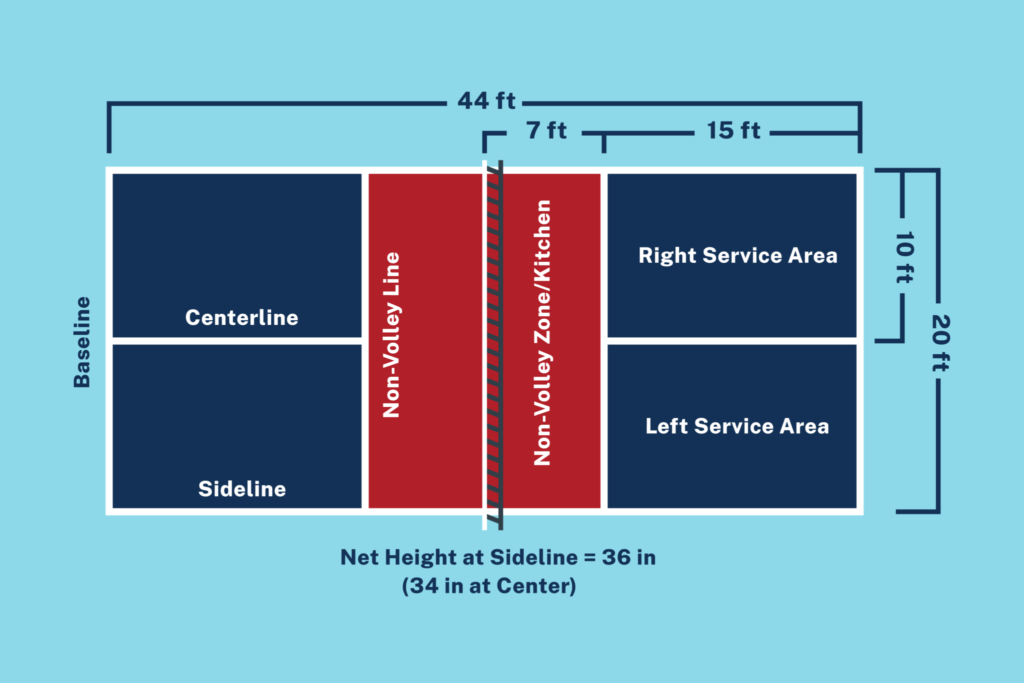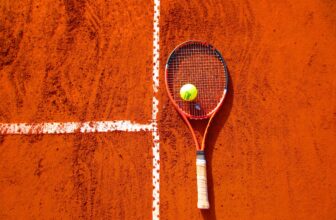Introduction
Welcome, sports enthusiasts, to the world of pickleball! If you haven’t heard of it yet, you’re in for a treat. This sport, despite its funny name, is taking the recreational world by storm. It’s a game that combines elements of tennis, badminton, and ping-pong, all while offering a unique and exciting experience. Today, we’re diving deep into the world of pickleball court dimensions, comparing them with their tennis and badminton counterparts. So, buckle up, and prepare for a journey filled with humor, fun facts, and perhaps a little bit of sweat!
The Pickleball Court: A Cozy Affair
In the world of sports, the pickleball court is like a cozy, welcoming living room. It’s a comfortable 20 feet wide and 44 feet long, making it the perfect size for a quick, engaging game. But don’t let its size fool you. This court is packed with unique features that make every game an exciting challenge.
One such feature is the non-volley zone, affectionately known as “the kitchen”. This 7-foot zone on both sides of the net is a place where you can’t volley the ball. It’s a rule that adds a strategic layer to the game, making it a blend of power and precision. And while you can’t cook in this kitchen, stepping into it at the wrong time can certainly heat things up in the game!
And here’s a fun fact to impress your friends at the next trivia night: a pickleball court is almost identical in size to a doubles badminton court. So, if you’re transitioning from badminton, you’ll feel right at home.
The Tennis Court: A Marathon Runner’s Dream
Next up, we have the granddaddy of them all, the tennis court. Stretching a whopping 78 feet long and 27 feet wide for singles (and 36 feet wide for doubles), it’s the marathon of the sports world. If you’ve ever felt like you’ve run a marathon after a tennis match, now you know why. The vastness of a tennis court is perfect for those who love to run… a lot.
To put it into perspective, a tennis playing area is nearly three times larger than a pickleball court, and a tennis court size is four times larger than pickleball courts. So, if you’re looking to clock in your daily step count, tennis has got you covered! But remember, while tennis might be a great way to stay in shape, it’s also a game that requires a lot of energy and stamina. So, if you’re looking for a game that’s a little less exhausting but just as fun, pickleball might be the sport for you.
The Badminton Court: The Middle Child
Now, let’s not forget about badminton, the middle child in this comparison. A doubles badminton court measures 44 feet long and 20 feet wide, identical to a pickleball court. However, don’t let the similar dimensions fool you. The dynamics of a badminton game are quite different, with shuttlecocks that can reach high speeds and drop dramatically, keeping you on your toes!
While pickleball is the laid-back sibling enjoying a sunny day, badminton is the energetic one, constantly on the move. It’s like comparing a leisurely bike ride to a high-speed motorcycle race! But despite their differences, both sports offer a great way to stay active and have fun.
Pickleball vs. Tennis: The Sweat Index
Now, let’s talk about the physical exertion required in pickleball and tennis. While both sports offer a great workout, pickleball is less tiring due to the smaller court size. It’s like getting the fun of tennis minus the marathon-like running. So, if you’re someone who values their sweat (and breath), pickleball might be the sport for you!
But don’t let the smaller court size fool you. Pickleball still offers a great workout. It’s a game that requires agility, strategy, and quick reflexes. So, while you might not run as much as in tennis, you’ll still get your heart pumping and your muscles working.
DIY Pickleball Court: Your Driveway’s New Best Friend
One of the best things about pickleball is how easy it is to set up a court. All you need is a flat surface, a net, a ball, and a paddle. You can set up a game on sports courts, level driveways, or even in your backyard. With a few simple steps, you can set up a regulation-size court perfect for singles or doubles play.
Imagine this: It’s a sunny Saturday afternoon, and instead of driving to the local rec center, you step into your driveway for a quick game of pickleball. No wait times, no court fees, just you, your paddle, and maybe a few curious neighbors. Now, that’s convenience at its best!
Pickleball Court Lines: Drawing the Boundaries
A pickleball court has several lines that define the boundaries of the game. These include sidelines, baselines, a centerline, and non-volley lines. All lines should be 2 inches wide and white for high contrast. The non-volley lines, or the “kitchen” lines, set the boundaries for the non-volley zones, where players aren’t allowed to volley the ball.
Here’s a breakdown of the key components of a pickleball court:
- Sidelines: These are the length lines of the court that run perpendicular to the net, forming the side boundaries of the court.
- Baselines: These are the width lines of the court that run parallel to the net. You serve from behind the baseline.
- Centerline: This line divides the court in half and runs from the baseline to the kitchen, creating the service areas on either side.
- Non-Volley Lines (Kitchen): These are parallel lines 7 feet from the net, on both sides of the court. They define the non-volley zone, also known as the “kitchen”. The lines are part of the non-volley zone.
- Service Areas: These are the areas on either side of the centerline. They are defined by the centerline, the sideline, the baseline, and the kitchen line. The right or even court service area is on the right side of the court when facing the net, and the left or odd court service area is on the left side.

Understanding these lines and their implications is crucial to mastering the game. For instance, knowing when to step into the kitchen and when to stay out can be the difference between winning and losing a point. So, next time you step onto a pickleball court, take a moment to familiarize yourself with these lines. Also, if you’re a beginner, definitely be sure to check out our pickleball guide for beginners, which consists of everything you need to know to master pickleball when you’re just starting out. And remember–it’s never a bad idea to invest in good gear!
Singles vs. Doubles: One Court, Two Games
Whether you’re playing singles or doubles, the court size remains the same. However, the dynamics of the game can change dramatically. In singles, one player defends the entire court, which can be a thrilling challenge. In doubles, communication and teamwork come into play, adding another layer of strategy to the game.
In doubles, players need to master the art of coordination and positioning. Knowing where to stand, when to move, and how to coordinate with your partner can be the key to a successful game. So, whether you’re a lone wolf or a team player, pickleball has something to offer you.
Building Your Own Pickleball Court: An Investment Worth Making
Building a pickleball court can be an investment, with costs ranging from $20,000 to $50,000 depending on the size, materials used, and location. However, the convenience and joy of having your own court can make it worth every penny. Plus, if you already have a tennis or badminton court, it can be converted into a pickleball court, making it a more cost-effective option.
But remember, building a court is just the first step. To truly enjoy the game, you need the right equipment. A good paddle, the right shoes, and high-quality balls can make a big difference in your game.
Conclusion
In conclusion, pickleball is a fun, accessible sport that offers a great workout without the marathon-like running of tennis. It’s a game that’s easy to set up, easy to learn, and most importantly, easy to fall in love with.
Whether you’re a seasoned athlete or a beginner looking to try something new, pickleball has something to offer. All you need is a paddle, a ball, and a court, and you’re ready to go. So, why not give it a try? Your driveway is waiting!
And remember, even if you’re a beginner, don’t hesitate to invest in good gear. If you need help deciding the right gear for you, definitely check out our buyer guides using the buttons below.
A quality paddle, comfortable shoes, and durable balls can enhance your game and make your pickleball experience even more enjoyable. So, gear up, step onto the court, and let the fun begin!








[…] court compare to those of tennis and badminton courts, feel free to check out our blog post here. The game is played with a hard paddle and a polymer ball with holes, and can be played as doubles […]
[…] The most important change is lowering the net height. Tennis nets are 3 feet high at the center, while pickleball nets are 2 feet 6 inches. Most tennis nets can be ratcheted down to the proper pickleball height. For everything you need to know about the dimensions of a pickleball court, click here. […]
[…] court compare to those of tennis and badminton courts, feel free to check out our blog post here. The game is played with a hard paddle and a polymer ball with holes, and can be played as doubles […]